Abstract
In HIV-infected patients, the use of protease inhibitors (PIs) is associated with a constellation of abdominal obesity; buffalo hump; decreased facial and subcutaneous fat; hyperlipidemia and type-2 diabetes mellitus, a so-called HAART-associated dysmetabolic syndrome. The incidence and prevalence of one of its components, the type-2 diabetes mellitus, among minority population is unknown. In August and September 1999, we reviewed 101 charts of HIV-infected patients who visited an inner-city HIV outpatient clinic. The age, gender, ethnicity, BMI, fasting plasma glucose, random serum glucose, triglycerides, CD4 counts, and the type and duration of antiretroviral drugs were recorded. Three years later (2002), the same patient charts were reviewed for evidence of new-onset diabetes. Ten percent of the subjects were identified as diabetic at baseline. The prevalence of diabetes was 12% among those who were taking PIs, compared to 0% among those who were not taking PIs. The incidence of newly diagnosed diabetes during this three-year period was 7.2%. Diabetes occurred only in the group taking PIs. Diabetic subjects were older than their nondiabetic counterparts. All were African Americans. Our study suggests that PIs increase the likelihood of diabetes developing with increasing age in African Americans infected with HIV.
Full text
PDF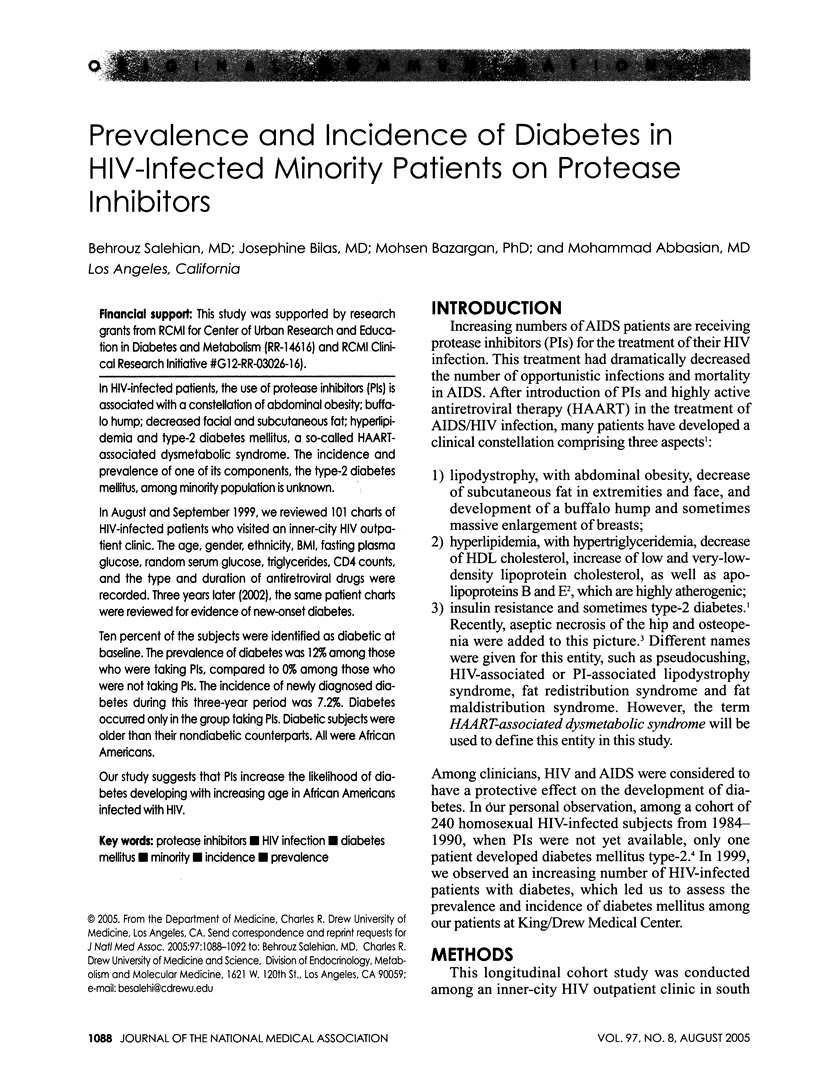
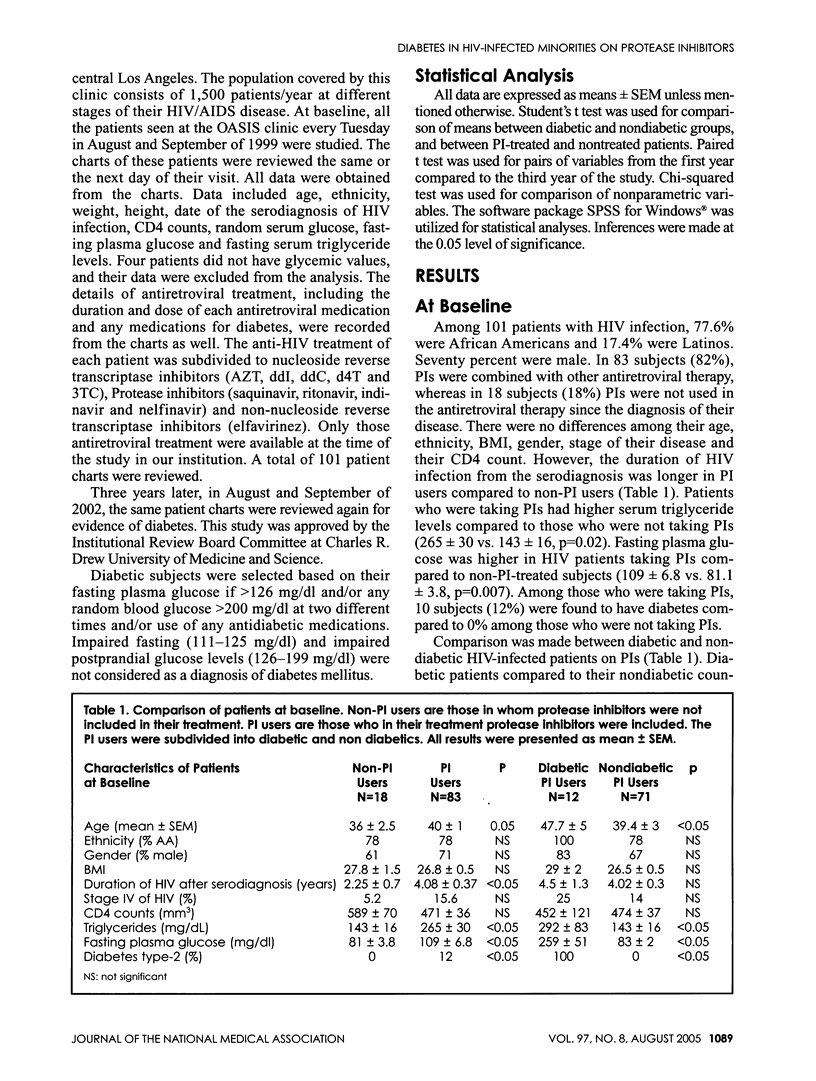
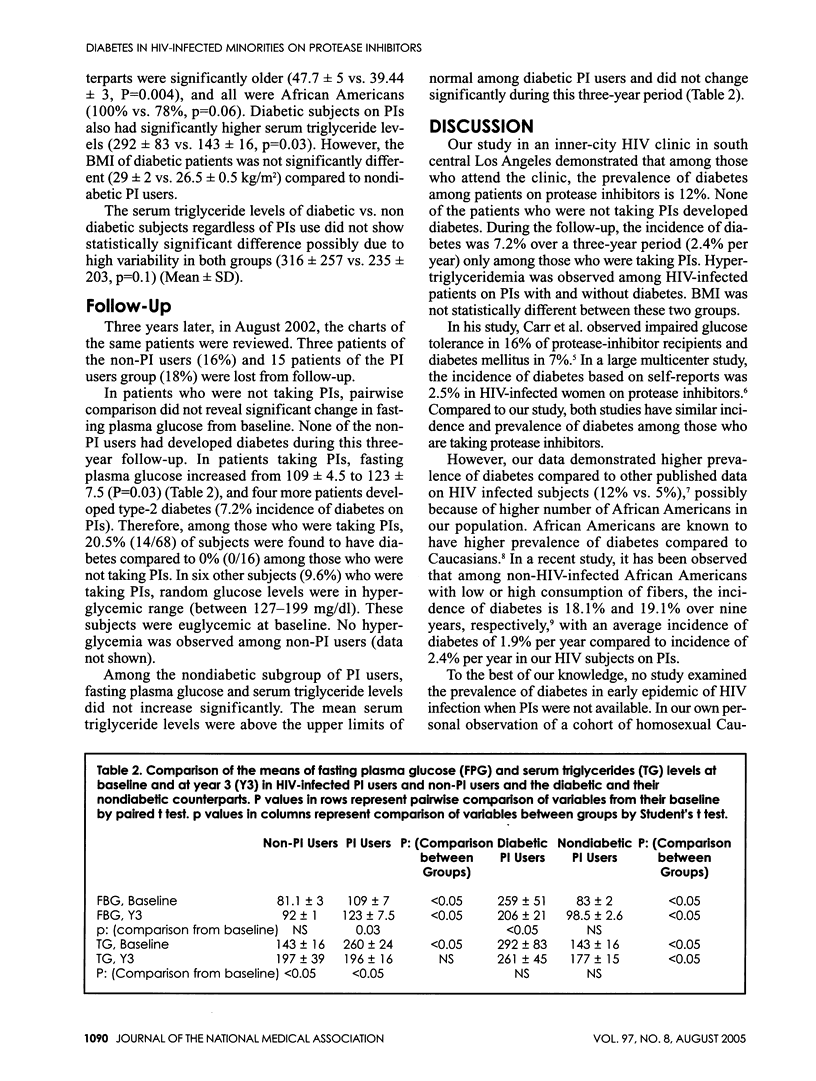
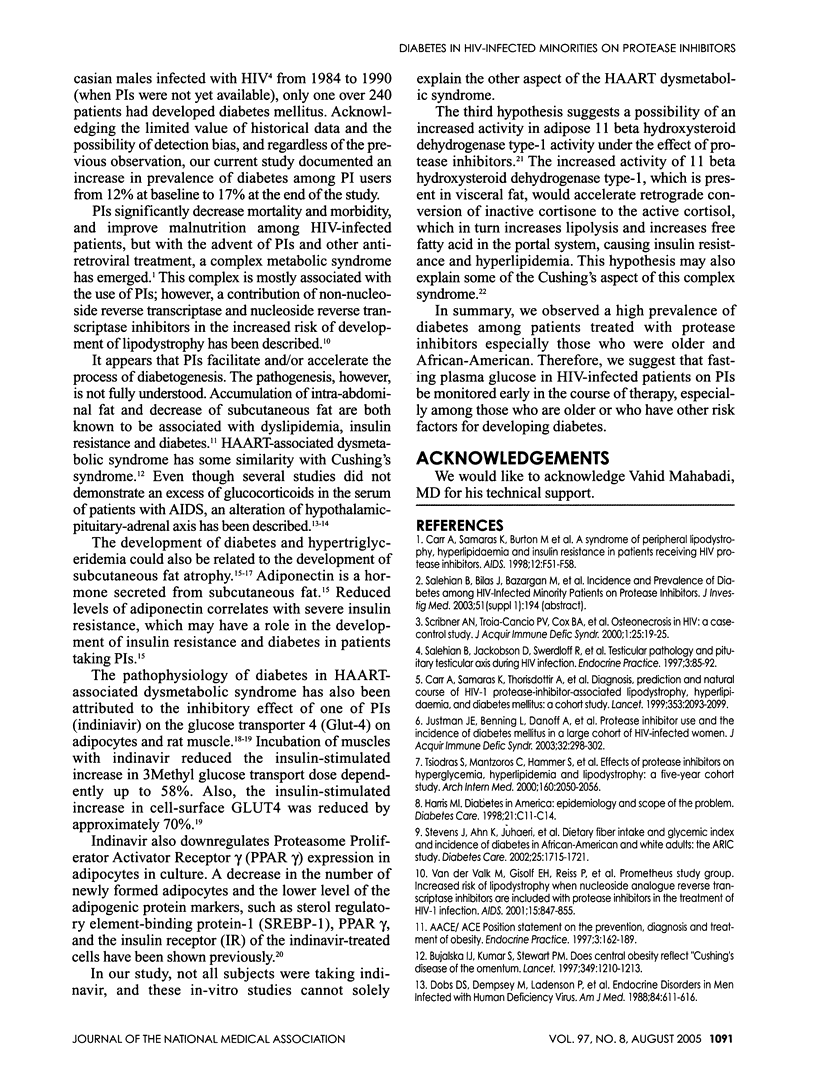
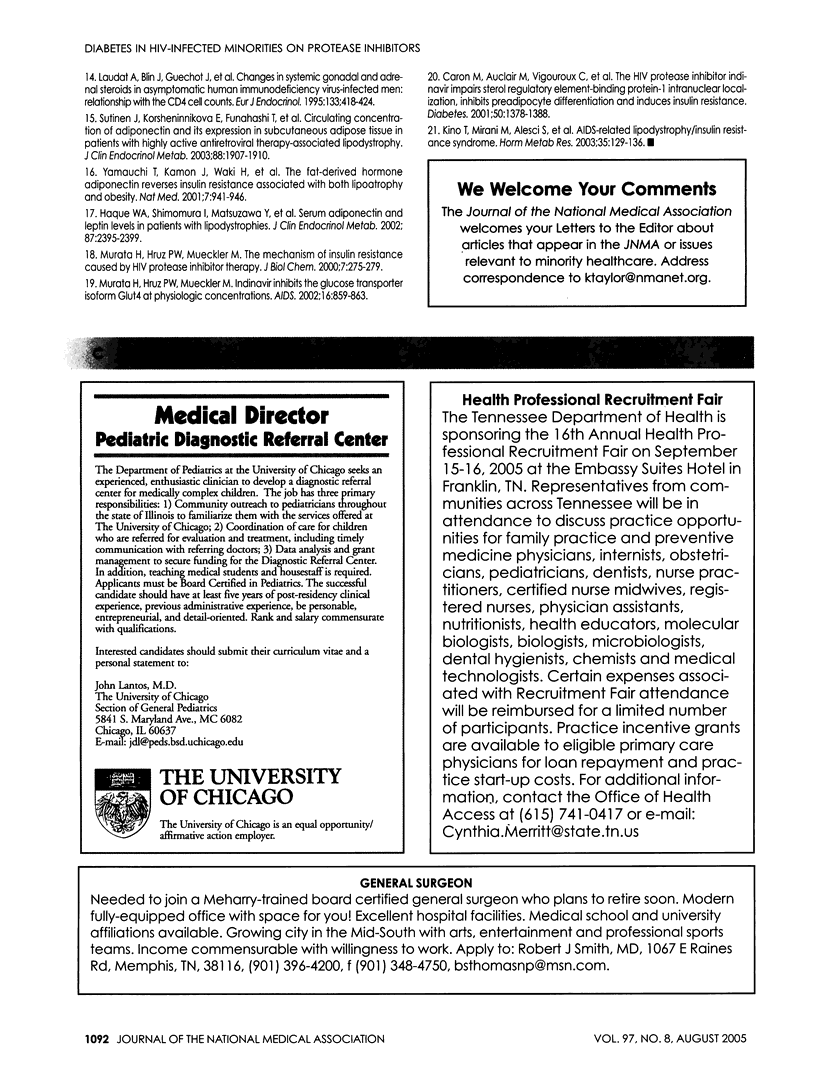
Selected References
These references are in PubMed. This may not be the complete list of references from this article.
- Bujalska I. J., Kumar S., Stewart P. M. Does central obesity reflect "Cushing's disease of the omentum"? Lancet. 1997 Apr 26;349(9060):1210–1213. doi: 10.1016/S0140-6736(96)11222-8. [DOI] [PubMed] [Google Scholar]
- Caron M., Auclair M., Vigouroux C., Glorian M., Forest C., Capeau J. The HIV protease inhibitor indinavir impairs sterol regulatory element-binding protein-1 intranuclear localization, inhibits preadipocyte differentiation, and induces insulin resistance. Diabetes. 2001 Jun;50(6):1378–1388. doi: 10.2337/diabetes.50.6.1378. [DOI] [PubMed] [Google Scholar]
- Carr A., Samaras K., Burton S., Law M., Freund J., Chisholm D. J., Cooper D. A. A syndrome of peripheral lipodystrophy, hyperlipidaemia and insulin resistance in patients receiving HIV protease inhibitors. AIDS. 1998 May 7;12(7):F51–F58. doi: 10.1097/00002030-199807000-00003. [DOI] [PubMed] [Google Scholar]
- Carr A., Samaras K., Thorisdottir A., Kaufmann G. R., Chisholm D. J., Cooper D. A. Diagnosis, prediction, and natural course of HIV-1 protease-inhibitor-associated lipodystrophy, hyperlipidaemia, and diabetes mellitus: a cohort study. Lancet. 1999 Jun 19;353(9170):2093–2099. doi: 10.1016/S0140-6736(98)08468-2. [DOI] [PubMed] [Google Scholar]
- Haque Wasim A., Shimomura Iichiro, Matsuzawa Yuji, Garg Abhimanyu. Serum adiponectin and leptin levels in patients with lipodystrophies. J Clin Endocrinol Metab. 2002 May;87(5):2395–2395. doi: 10.1210/jcem.87.5.8624. [DOI] [PubMed] [Google Scholar]
- Justman Jessica E., Benning Lorie, Danoff Ann, Minkoff Howard, Levine Alexandra, Greenblatt Ruth M., Weber Kathleen, Piessens Eva, Robison Esther, Anastos Kathryn. Protease inhibitor use and the incidence of diabetes mellitus in a large cohort of HIV-infected women. J Acquir Immune Defic Syndr. 2003 Mar 1;32(3):298–302. doi: 10.1097/00126334-200303010-00009. [DOI] [PubMed] [Google Scholar]
- Kino T., Mirani M., Alesci S., Chrousos G. P. AIDS-related lipodystrophy/insulin resistance syndrome. Horm Metab Res. 2003 Mar;35(3):129–136. doi: 10.1055/s-2003-39072. [DOI] [PubMed] [Google Scholar]
- Laudat A., Blum L., Guéchot J., Picard O., Cabane J., Imbert J. C., Giboudeau J. Changes in systemic gonadal and adrenal steroids in asymptomatic human immunodeficiency virus-infected men: relationship with the CD4 cell counts. Eur J Endocrinol. 1995 Oct;133(4):418–424. doi: 10.1530/eje.0.1330418. [DOI] [PubMed] [Google Scholar]
- Murata Haruhiko, Hruz Paul W., Mueckler Mike. Indinavir inhibits the glucose transporter isoform Glut4 at physiologic concentrations. AIDS. 2002 Apr 12;16(6):859–863. doi: 10.1097/00002030-200204120-00005. [DOI] [PubMed] [Google Scholar]
- Scribner A. N., Troia-Cancio P. V., Cox B. A., Marcantonio D., Hamid F., Keiser P., Levi M., Allen B., Murphy K., Jones R. E. Osteonecrosis in HIV: a case-control study. J Acquir Immune Defic Syndr. 2000 Sep 1;25(1):19–25. doi: 10.1097/00042560-200009010-00003. [DOI] [PubMed] [Google Scholar]
- Stevens June, Ahn Kyungmi, Juhaeri, Houston Denise, Steffan Lyn, Couper David. Dietary fiber intake and glycemic index and incidence of diabetes in African-American and white adults: the ARIC study. Diabetes Care. 2002 Oct;25(10):1715–1721. doi: 10.2337/diacare.25.10.1715. [DOI] [PubMed] [Google Scholar]
- Sutinen Jussi, Korsheninnikova Elena, Funahashi Tohru, Matsuzawa Yuji, Nyman Tuulikki, Yki-Järvinen Hannele. Circulating concentration of adiponectin and its expression in subcutaneous adipose tissue in patients with highly active antiretroviral therapy-associated lipodystrophy. J Clin Endocrinol Metab. 2003 Apr;88(4):1907–1910. doi: 10.1210/jc.2002-021922. [DOI] [PubMed] [Google Scholar]
- Tsiodras S., Mantzoros C., Hammer S., Samore M. Effects of protease inhibitors on hyperglycemia, hyperlipidemia, and lipodystrophy: a 5-year cohort study. Arch Intern Med. 2000 Jul 10;160(13):2050–2056. doi: 10.1001/archinte.160.13.2050. [DOI] [PubMed] [Google Scholar]
- Yamauchi T., Kamon J., Waki H., Terauchi Y., Kubota N., Hara K., Mori Y., Ide T., Murakami K., Tsuboyama-Kasaoka N. The fat-derived hormone adiponectin reverses insulin resistance associated with both lipoatrophy and obesity. Nat Med. 2001 Aug;7(8):941–946. doi: 10.1038/90984. [DOI] [PubMed] [Google Scholar]
- van der Valk M., Gisolf E. H., Reiss P., Wit F. W., Japour A., Weverling G. J., Danner S. A., Prometheus study group Increased risk of lipodystrophy when nucleoside analogue reverse transcriptase inhibitors are included with protease inhibitors in the treatment of HIV-1 infection. AIDS. 2001 May 4;15(7):847–855. doi: 10.1097/00002030-200105040-00005. [DOI] [PubMed] [Google Scholar]


